
Please send all Checks and Money orders to :
Dave Taylor P.O. Box 87 Sylvania, OH 43560
419-842-1863
Click Here to E-mail Us!
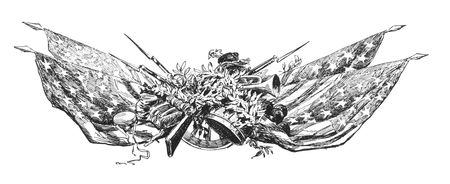
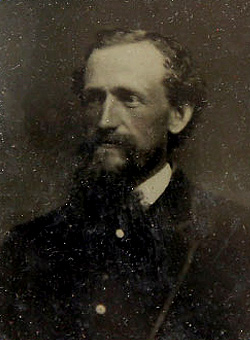
15 06 third list
LAYAWAYS ARE WELCOME:
Need to split your order into multiple payments? No problem! A simple 20% earnest money deposit will hold your item for you.
You can then pay it off in easy installments that fit your budget.
Read Terms Here
~~~~~~~~~~

15-06-71 … 4th Michigan Cavalry Group …
A group like we used to find! Straight from the family of the soldier … an identified officer’s sword, sash and straps, along with photos of him and family members. This group was preserved by descendants of Wesley H. Leach, 1st and 4th Michigan Cavalry. Leach enlisted as a private in the 1st Michigan Cavalry 8/12/61 and mustered into Co. D the same day. He made 2nd Lieutenant 9/6/62, but was supernumerary (an additional Lieutenant more than necessary for the company) and was then promoted to 1st Lieutenant and transferred to Co. H of the 4th Michigan Cavalry on 12/19/62. He served with that unit until his discharge for disability on 8/24/64, becoming captain of Co. A on 3/31/63.
This group includes Leach’s Horstman-marked 1850 Staff and Field Officer’s sword, his crimson officer’s sash, a very nice pair of triple-bordered cavalry captain’s shoulder straps, a cased 9th plate tintype of Leach himself, and three uncased tintypes: one of his son Frank, one of his daughter and another of an older Leach with a grandson. The use of an 1850 Staff and Field officer’s sword by a cavalryman is not unheard of- the sword was longer than the 1850 foot officer’s, and was intended to be carried by officers who were mounted- hence the use of a metal scabbard. Leach’s shows “use but not abuse.” The wire is gone, but the sharkskin grip wrap is all there. And solid. The blade is a dull silver mixed with gray, but shows very vivid etching: floral motifs and a bold U.S. Full “W.H. Horstman & Sons Philadephia” etched maker panel just above the ricasso, even the “Iron Proof” etching on the back of the blade that is the first thing to go shows just minor rubbing and darkening. The hilt and brass mounts of the scabbard show matching patina and the outboard side of the scabbard shows a lot of original color. Interestingly, the inboard side shows more wear to the finish, showing more of a gray, along with a small dent between the mounts- obviously the result of being the side rubbing against the rider’s leg and horse’s side.
The sash shows just a few wear spots on high points of the tassels, no holes or runs, and lots of its original crimson, shifting just slightly towards purple on the knots. The straps are exceptional. The backs are typical openwork with a thin tarred paper showing wear. The folded edges of the cloth show a nice yellow on the back that has mellowed and oxidized toward a more mustard color on the faces, but with a good nap and gilt triple borders and bars that have not “zinced out,” but show a dull gilt finish with very few pulls. A few shorter sections of jaceron wire border are in place on the interior sections, if there were longer strands they probably snagged and pulled off during the period of use since these were plainly worn, not stored away in an epaulet tin.
The cased tintype shows Leach in an officer’s blouse. Other portraits of him are available- a quick search turned up listings in the army history collections at Carlisle. In the seated portrait likely taken in 1890s with a grandchild he is obviously older- he lived until 1904. (NOTE: The photo in Carlisle Barracks is from the collection of David Tinder. Dave had sent his entire 4th Michigan Cavalry album to Carlisle for copying and adding to their archive. Carlisle returned the album by US mail uninsured and it was lost or stolen. What a shame.)
There are a number of documents with this supplied by the family. Most of the items the family sold through Schmidt’s Auction Service in Ypsilanti, Michigan. The buyer of that material contacted the family afterward and obtained the rest. Leach’s service record includes time with the 1st Michigan when they served in the Army of the Potomac, Dept. of the Shenandoah, and Army of Viriginia, seeing action in the Valley and elsewhere. CWdata provides more than 50 entries for engagements or losses of the regiment during this time period. After moving to the 4th Michigan Cavalry, Leach was part of Minty’s Cavalry Brigade in the Army of the Cumberland and the Department and Army of the Cumberland and Ohio. They saw a tremendous amount of action against Wheeler, Forrest and Morgan, as well as numerous raids and battles in Tennessee and Georgia. At Chickamauga they were the first to tangle with advancing Confederates, but their warnings to the Union high command were met with disbelief. In the Atlanta campaign they served under Kilpatrick- no easy assignment. Just to give a rough idea of their activity, CWdata lists another 75 entries for actions and casualties for the regiment during the period Leach was in it. This is a wonderful archive and family trove from a very active cavalry officer in the Civil War … noco
… $2,850.00 – SOLD
Click Here to E-mail Us!
Call us @ 419-842-1863

15-06-72 … Massive 1860 I-XL Bowie Knife …
A giant 1860s fighting knife measuring 15 inches overall in the sheath… perhaps the largest Bowie Knife I have owned… MUCH larger than the famed Rio Grande Camp Knives of the same pattern. Made and marked by “G. Wolstenholm & Son/ Washington Works/ Sheffield” with their mark on the upper left side of the blade and the “I-XL” mark on the ricasso and matching gilt blind-stamped mark on the sheath. This is a hefty utilitarian frontiersman’s and soldier’s belt knife with German silver mounts: oval-section flat crossguard … inset escutcheon panel in the left slab of the grip … german silver throat and tip on the scabbard. Minor seam opening on the leather covered pasteboard scabbard, some wear and loss to the leather, but complete and solid with much of the gilt embossing left. Rivet on the upper part of the scabbard and at the throat shows the owner did away with the small button stud seen on some knives and chose a sturdier belt loop, which is now gone. The massive blade is solid and has a large chip about 1/3 down from the tip, two smaller notches, and a little roughness to the edge toward the tip. There are also numerous dark spots mixed with the silver gray overall. This is an impressive Bowie with a substantial back edge leading from the spearpoint and would look great with a frontiersman’s or soldiers outfit from the 1850 to 1860s period. The Rio Grande Canp knives bring many thousands only because of the reference to the river in Texas in their logo. This is a better knife. This is a bigger knife. This is a good value on an antique Bowie
… $2,750.00
Click Here to E-mail Us!
Call us @ 419-842-1863
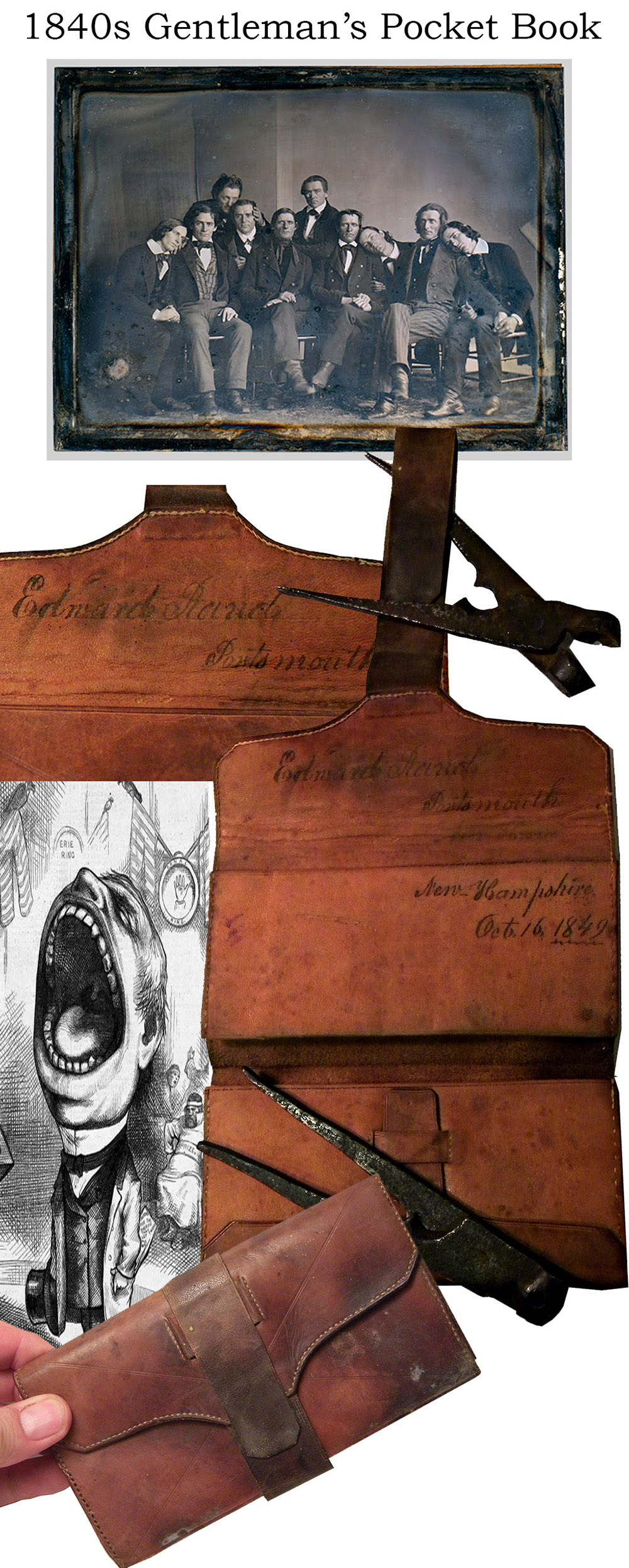
15-06-73 … 1840s New Hampshire Businessman’s Wallet or Pocket Book …
Excellent condition folding three section brown leather wallet, nicely ink inscribed with the owner’s name and home town. “Edward Rand Portsmouth New Hampshire 1849”. A quick check on-line finds our likely owner was born in 1806, was 44 years old on the 1850 census, lived in Portsmouth, Rockingham County, New Hampshire, and was a Grocer. I also see he had a son born in 1837 named Edward A. Rand (13 years old on the census). This boy grew up to be a minister in town and died in 1903. Amazing what we can learn on the internet in a few moments on the computer. A neat period personal item that is nearly 170 years old
… $145.00 – SOLD
Click Here to E-mail Us!
Call us @ 419-842-1863
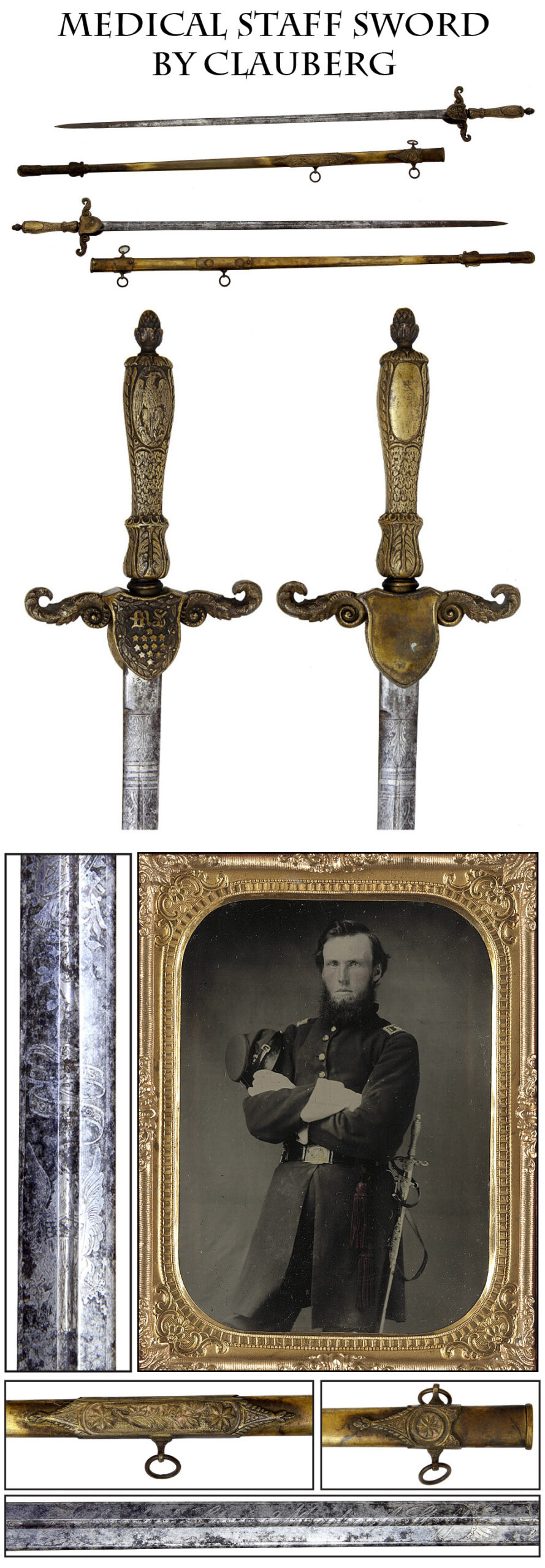
15-06-74 … Medical Staff Sword — Surgeon’s Sword by Clauberg …
Civil War regiments were allotted one Surgeon with field rank and one Assistant Surgeon, ranking as a lieutenant, until the fall of 1862 when two Assistant Surgeons were authorized. These officers were considered the “Medical Staff” of the regiment and were uniformed with distinctive insig.nia and swords. This is the 1840 pattern Medical Staff used throughout the Civil War. The brass grip is cast with oak, acorn and acanthus leaf motifs and the pommel is topped with a pineapple shaped finial. An oval panel on one side is blank; on the other side and American eagle fills the space. Two shield shaped langets drop from the scrolled crossguard, blank on one side and with an old-English “MS” over thirteen stars on the other. The patina is an untouched mellow tone with darker areas in low spots. The brass scabbard has a matching patina and mounts with deeply cast floral motifs. No dents, throat and all carrying rings in place. The blade is a good early form, oval in cross section with a central fuller, and is a mix of gray and bright, with very visible etching: floral and geometric motifs with an eagle and ribband on one side and a long oval panel etched with “United States Medical Staff” on the other. 30 inch blade is signed on the ricasso “W. Clauberg” . Civil War surgeons were expected to set up field aid stations close to the battle lines and more than one lost his life in the fighting while trying to save the lives of others. A very representative example of a very scarce sword … noco
… $1,695.00 – SOLD
Click Here to E-mail Us!
Call us @ 419-842-1863
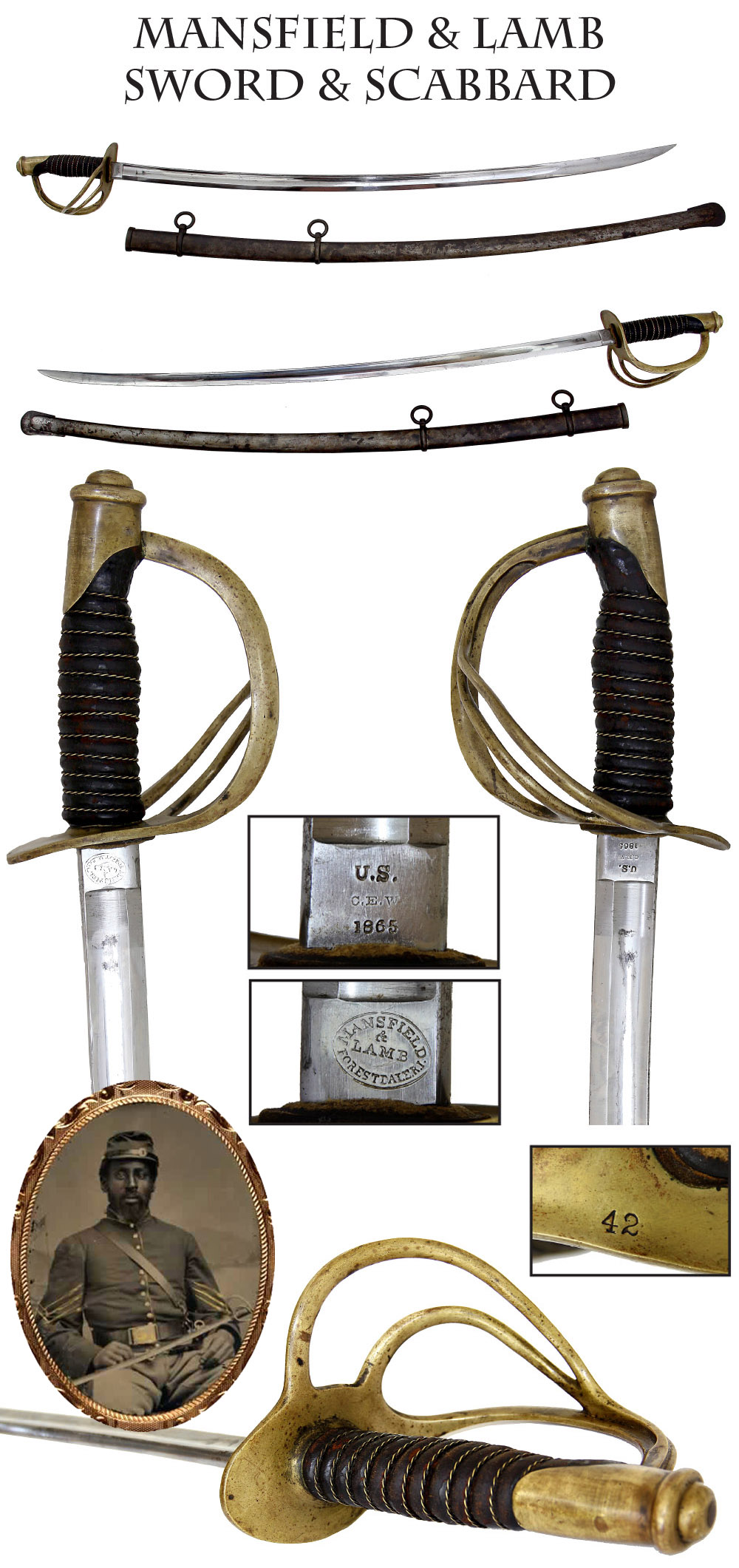
15-06-75 … 1860 Cavalry Saber by Mansfield and Lamb …
The quintessential Civil War cavalry arm: the 1860 pattern US light cavalry saber. Actually introduced in 1857, this weapon was made by a number of manufacturers on contract to the US government, to various states and organizations and even for sale privately. Here is an 1865 dated example by Mansfield and Lamb of Forestdale, RI, showing their mark on one side of the ricasso and the US and 1865 date on the other, along with the C.E.W. initials of a government inspector. Full leather and wire on the grip, just some abrasion from light wear. The blade is excellent, showing much factory luster with just some minor spotting from the scabbard retention spring, and it still preserves the original cross-polishing above the ricasso. Crisp marks, a rack number “42” on the guard showing it was actually issued. Mellow patina to the brass. Scabbard a mix of dull silver gray with some brown areas. Carrying rings, throat, etc. in place. Late war date, but a great example and some of the big cavalry raids were in 1865. Also good, of course, for a Custer related plains war collection as well. A solid example with super blade … f-17034
… $765.00 – SOLD
Click Here to E-mail Us!
Call us @ 419-842-1863
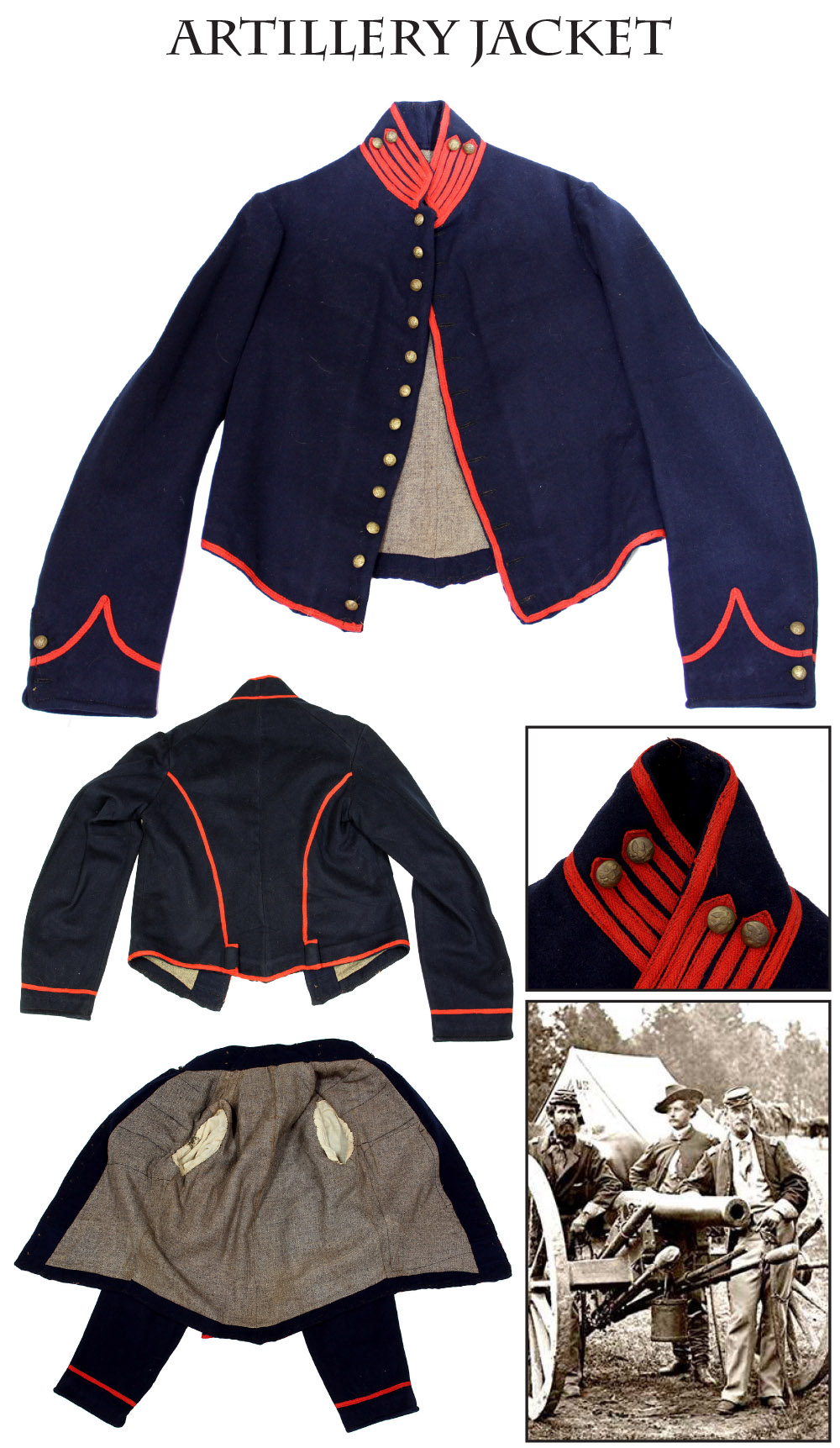
15-06-76 … 15-06-76 … Near Mint Artillery Jacket …
U.S. Regulation Civil War Light Artillery Shell Jacket. This is the artillery jacket worn by light artillerymen in the field. Has tall stand-up piped collar, with red tape piping on the front, cuffs, base of the jacket, and from the shoulder to the waist on the back. The red trim of course represents artillery. This example is about perfect. It has the full muslin sleeve and wool body linings totally intact. The right sleeve bears two brown ink dots indicating “size 2”. (the army issued them in four standard sizes, 1 being small 4 being large). The right sleeve lining also bears a smudged oval ink stamp that is either the maker’s or US Inspector’s mark. These are the most colorful of regulation Federal uniforms and they display like a million dollars while being priced quite affordably … noco
… $1,975.00 – SOLD
Click Here to E-mail Us!
Call us @ 419-842-1863
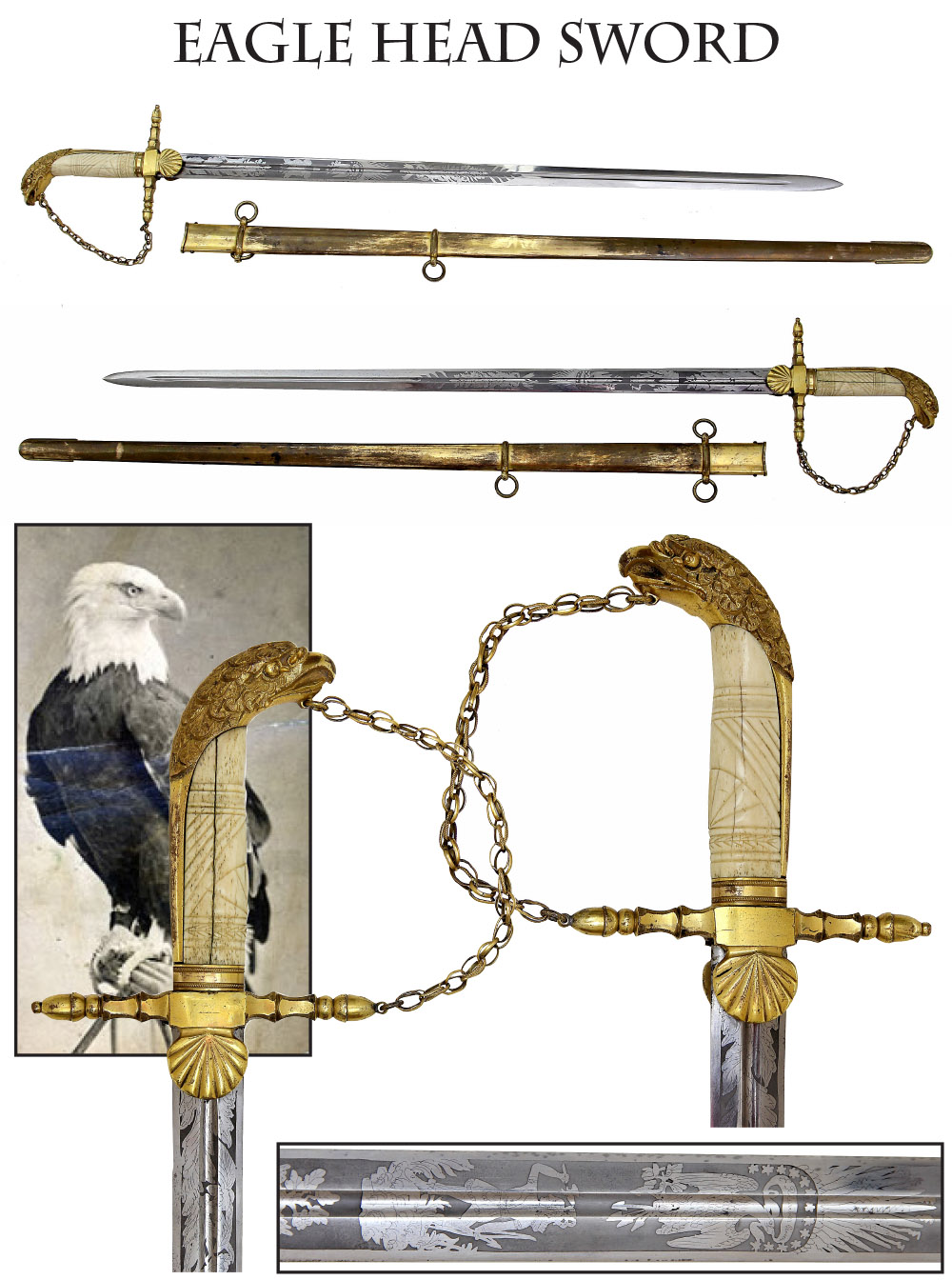
15-06-77 … Ultra Attractive American Eagle Head Sword …
Magnificent… as-found… beautiful eagle pommel sword, with lots of original gilt on the hilt and scabbard. The blade is near MINT condition. Bone grip intact… one longitudinal crack on one side… two inconsequential hairlines on the other,… solid and stable. Nicely formed curved neck eagle’s head pommel with plain backstrap and chain guard connecting to one of two pineapple finials on the cross guard, which is straight. The eagle is as ferocious and handsome as any I have encountered. The guard is faceted and has to two downward turned shell-shaped langets. Grip has geometric incised lines. Superb, wide, straight double-edged blade with oval cross section and central fuller. Vivid beautiful etching on a minty bright blade. Has the usual floral motifs with a great US eagle and stars above and Indian brandishing a bow and tomahawk symbolizing America. Gilt brass scabbard shows about 40 percent bright, the rest a darker untouched patina. Throat, drag and all carrying rings present. A very nice sword of about 1840-1860 that would show very well in an edged weapons collection. One of the prettiest eagle heads I’ve owned … bajj-eub
… $2,650.00
Click Here to E-mail Us!
Call us @ 419-842-1863

15-06-78 … PS Justice Heavy Cavalry Saber …
Nice 1840 pattern cavalry saber by P.S. Justice of Philadelphia. We tend to think of these as Mexican War patterns, but the heavier weight saber was preferred by some up into the Civil War and was the pattern followed by many commercial makers and suppliers. Justice supplied some 13,000 cavalry sabers to the government on contracts dating from August, 1861 through February, 1862. This is the Justice “Type-II” 1840, made by Schnitzler and Kirschbaum, imported by Justice and stamped with his mark on the ricasso, but preserving the S&K stamp on the drag. Full leather and wire, mellow untouched patina to the brass guard. Blade has a good edge with no nicks and shows a dull silver with some areas of very slight graying. Scabbard has throat, drags, mounts and rings in place, showing a toned down silver gray mixed with some brown areas, and no dents. An excellent example of an early war scarce saber … ej-140502
… $875.00 – SOLD
Click Here to E-mail Us!
Call us @ 419-842-1863
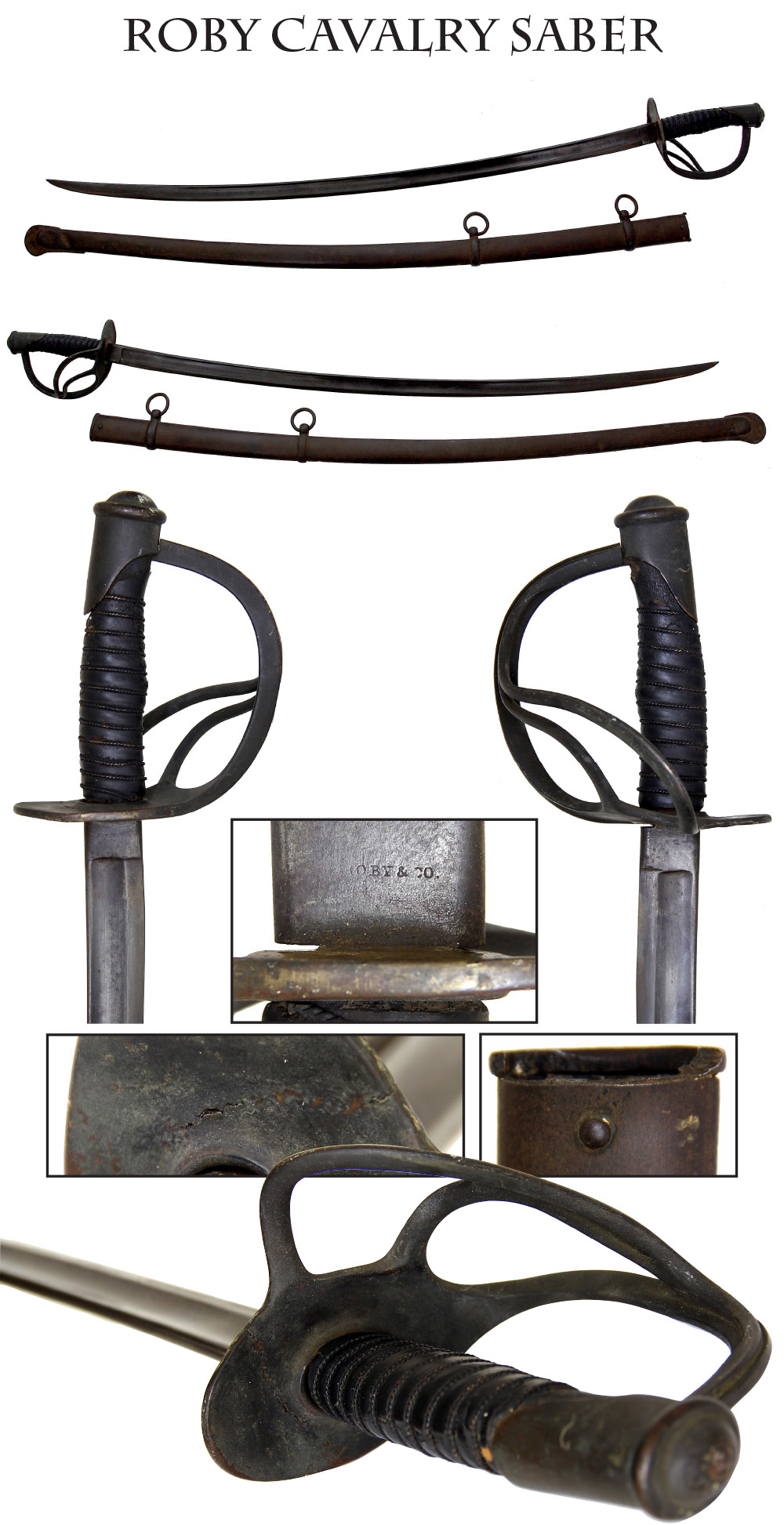
15-06-79 … Roby Pre-Contract Early 1861 Cavalry Saber – 1st Vermont Cavalry??? …
Roby was one of the big suppliers of cavalry sabers to the US government, but his first federal contract was not until July, 1863. In December, 1861, however, he supplied 410 sabers to the Ordnance Department on direct purchase that had a simple “C. Roby & Co.” straight line stamp as does this one. It was first believed that these sabers were made for a state contract. But the discovery of another saber with this early straight line firm marking was also marked “1st Vt. Cav” over-stamped on the ricasso with inspector marks… giving rise to the theory that most if not all of these early straight line stamped sabers were purchases for that hard-fighting unit. Hilt has a dark untouched patina. Grip leather and wire are VG. No washer at the blade shoulder and the guard shows a slight impact bend at the bottom and a narrow fracture at the top. The blade is gray overall with some very light pitting at the ricasso. The scabbard is an import 1860 pattern with a riveted throat that shows wear to the edges and some chipping on the back of the throat. A very scarce US cavalry saber … b-sonor
… $495.00 – SOLD
Click Here to E-mail Us!
Call us @ 419-842-1863
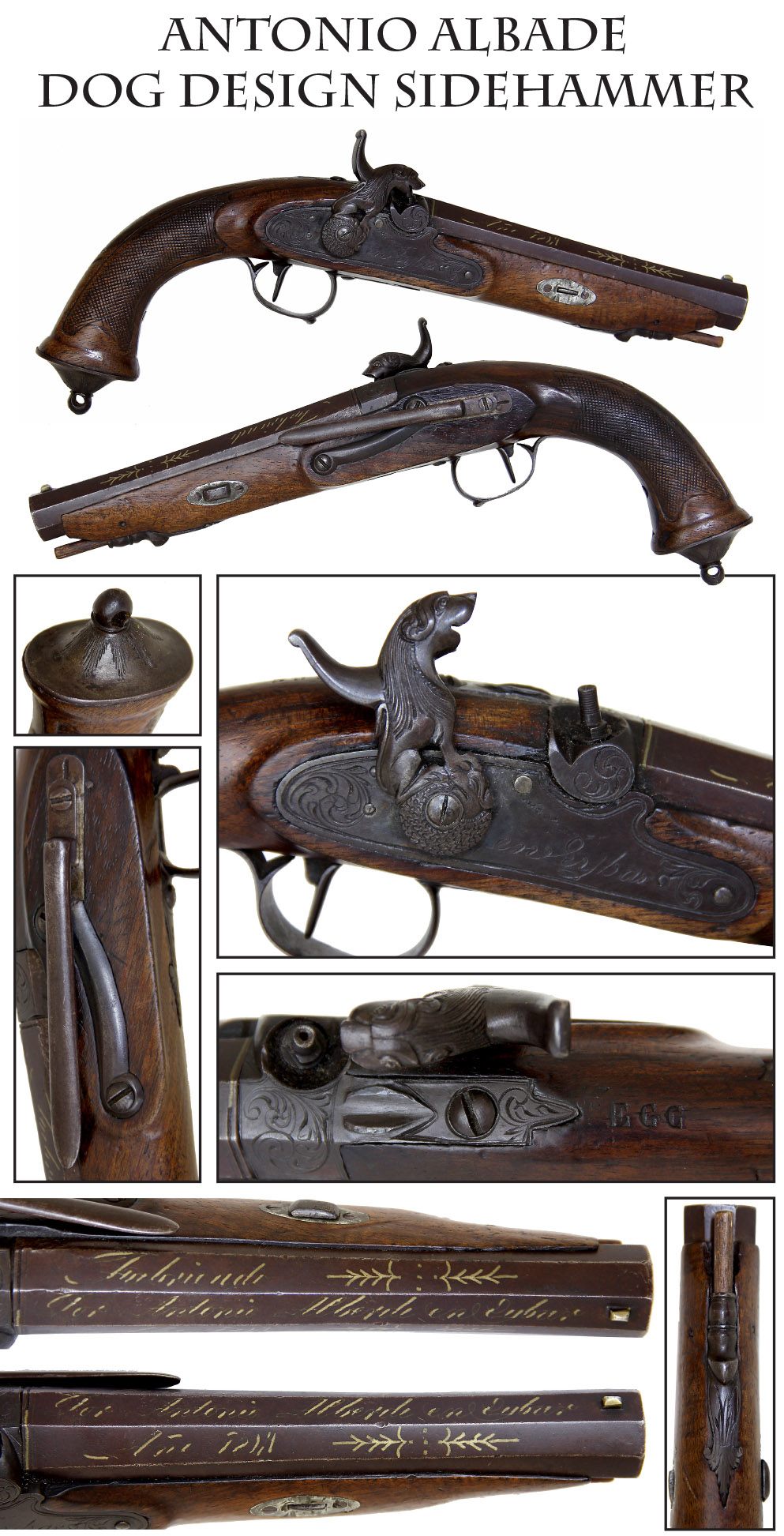
15-06-80 … Antonio Albade Belt Pistol …
A sculpted hammer in the form of a seated lion adorns the lock of this belt pistol of about 1850. Tightly checkered pistol grip with a flared butt cap from which extends a lanyard ring. This octagonal barreled single shot percussion pistol has a belt hook on the left side indicating it was to be carried on the belt or waistband of a well-heeled owner. Nice quality European walnut stock with the barrel secured by a single wedge. Ramrod a simple recent replacement. Barrel shows original lacquer brown finish and gold inlaid maker’s signature and location. Rear sight is a simple raised notch with floral engraving on the breech plug tang and next to the recessed nipple. The lockplate shows faded case color and bears engraved floral motifs. It is engraved on the bolster and rear of the lockplate , the same design gets picked up by thick foliage on the lower hammer around the screw, upon which sits a lion with extended neck that ends in a somewhat dog-like head and open mouth that forms the face of the hammer. Really cool. The thumb piece extends from the animal’s back, just above the long, curled tail. The nipple shows no battering and there is no firing corrosion in the bolster area. A single ramrod thimble has floral engraving matching other elements of the gun. The letters “EGG” are stamped behind the breechplug tang, perhaps an owner name. A lot of quality for a little bit of money … dej-xz
… $950.00 – SOLD
Click Here to E-mail Us!
Call us @ 419-842-1863
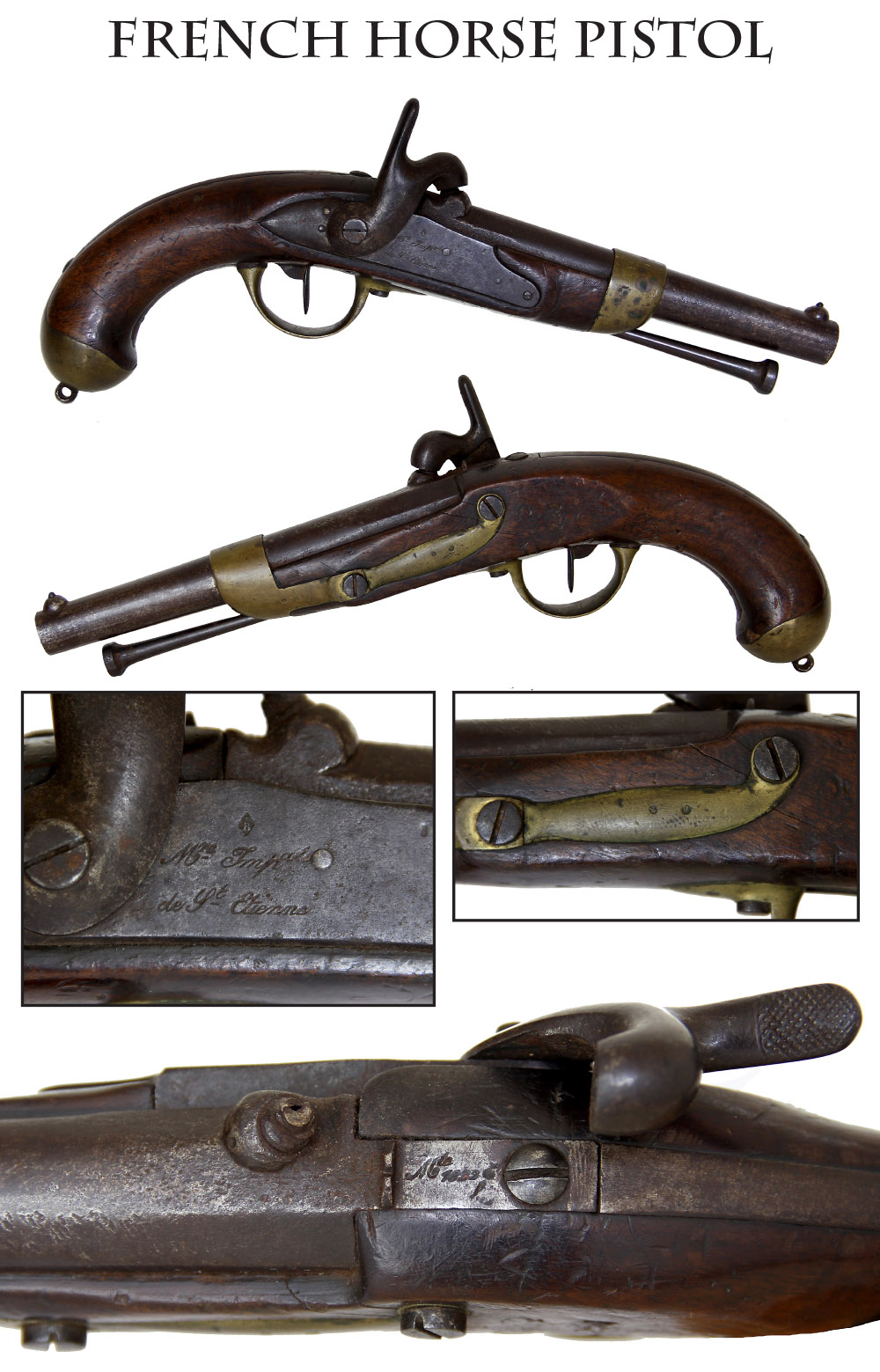
15-06-81 … French Cavalry Pistol …
A great old war horse … French 1822 pattern cavalry pistol. Clear model date on the breech plug tang and lock plate markings indicating manufacture at St. Etienne during the reign of Napoleon III. These pistols underwent a number of modifications and stayed in service until the 1860s, qualifying for use in the Crimean War and the French troubles in Mexico. Converted from flintlock… Ours shows the round front sight base indicating it went through the rifling process about 1860, though the ramrod is an older simple flat head rammer instead of the heavy cupped rammer. Nipple shows some battering and chipping and there is firing corrosion around the bolster showing this saw use. The action is good and the lanyard ring on the butt is in place. Minor dings and scratches to the wood, metal brown mixed with a dull pewter tone. Early collectors believed numbers of these came into Texas for use by the Rebs, but I’m aware of no records to support the belief. It is a reasonable assumption though … xcjj-veg
… $495.00 – SOLD
Click Here to E-mail Us!
Call us @ 419-842-1863

15-06-83 … Extra Fine Cooper Double Action Revolver …
A nice Cooper third model pocket revolver showing lots of case color on the frame and hammer and lots of nice blue on the cylinder and barrel. These double-action .31 revolvers were made in Pittsburgh and then in Philadelphia starting about 1864. This has matching serial number 11213, placing it early in the third model series that Flayderman says started about number 11,000. Very nice even mellow patina to the brass. Practically unblemished varnished grips, just one or two fingernail size indentations. The best part is the color: luminescent blue on the cylinder, a thin blue on the barrel showing bright just at the high points of the ridges, and a swirl of those “gasoline on water” colors you want to see on a frame. Full, correct three-line barrel markings for this model which omit the 1859 patent information and add 1863 dates, just a bit lightly stamped in the second and third lines toward the right (these were not as elegantly applied as Col. Colt’s.) A very nice gun that will make you want to upgrade most everything else in your collection … vadcg-ej-16895
… $1,850.00
Click Here to E-mail Us!
Call us @ 419-842-1863

15-06-84 … British 1842 Pattern Cavalry Pistol …
These larger bore single shot percussion pistols were issued to British cavalry troopers from 1842 to about 1860. Ours has a plain lockplate and simple Birmingham barrel proofs indicating it is a commercial version of the type supplied to militia regiments or purchased privately by an officer or NCO. Nice wood with sharp edges to the lock apron and very few handling dings. Mellow tone to the brass. Captive ramrod and swivel in place as are the flat forend cap and butt cap. Smokey blue-gray tones to the lock plate showing traces of case. Rubbed thin blue finish to the barrel. No corrosion. Small “WA” between the barrel proofs, and stamped in the wood just above the butt cap. Another nice Crimean War era cavalry pistol … cjj-17067
… $535.00 – SOLD
Click Here to E-mail Us!
Call us @ 419-842-1863
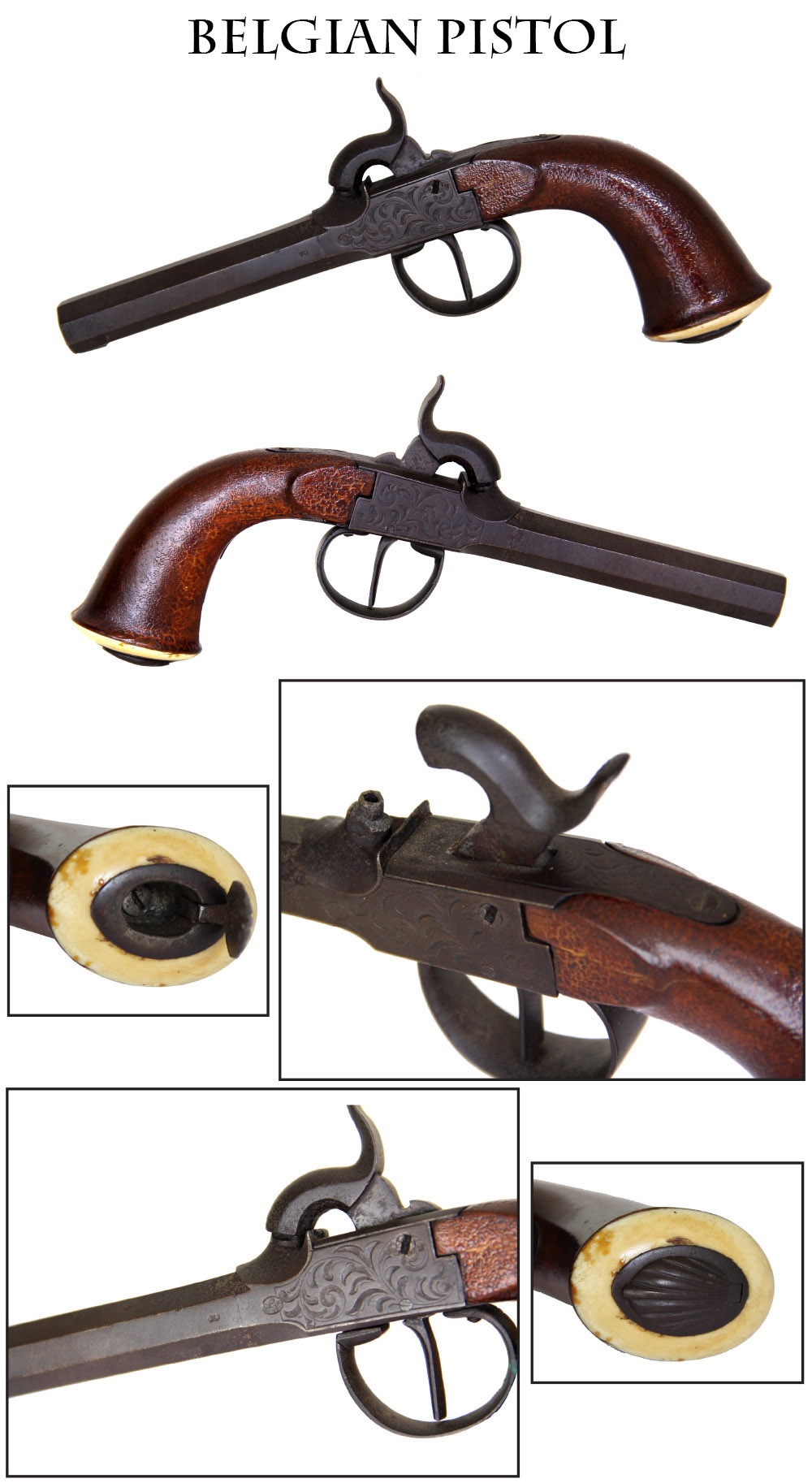
15-06-85 … Belgian Boot or Belt Pistol …
Single shot percussion coat pistol about nine inches overall length.. Simple and sturdy boxlock percussion pistol designed for carry in an overcoat pocket. Nice wood showing just a bit of shrinkage at the metal and crazing to the finish. Flaring grip with an inset cap container closed by a shell decorated cover with bone or ivory lip. Floral sprays engraved on the sides of the frame and breech tang. Mechanism good. Some wear to the nipple. Small maker or inspector mark on side flat of the octagonal barrel at the breech, just forward of an “ELG” cartouche on the frame. Metal has pretty full coverage of blue turning plum brown. A typical gentleman’s gun for self-defense on a night out in Paris of the 1840s … abe-17067
… $245.00 – SOLD
Click Here to E-mail Us!
Call us @ 419-842-1863
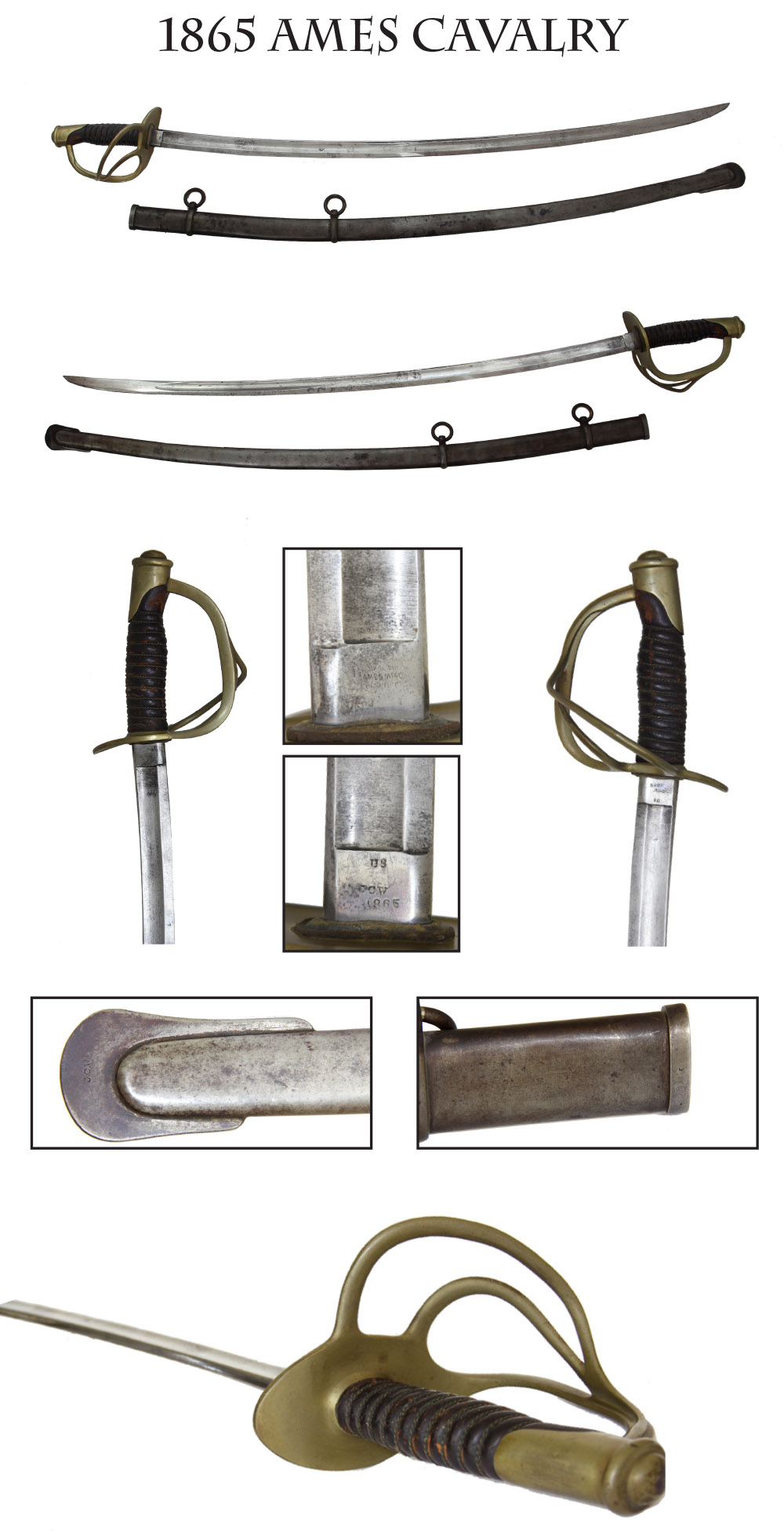
15-06-86 … Very Nice 1865 Ames Cavalry Saber w/ Matching Inspector Marks …
Ames is the most well known maker of edged weapons in the Civil War. This is a nice example of the regulation Union cavalry saber – the 1860 light cavalry, which replaced the heavier 1840 dragoon saber starting about 1857. This shows very clear US JCW inspector marks and date on one side of the ricasso and the scroll Ames maker stamp on the other, which is typically a bit lightly stamped, but legible. Nice blade, mostly bright, but mixed with gray here and there, particularly toward the hilt. Good tip and edge with no nicks. Leather pad is in place at the blade shoulder and the grip is excellent with full original leather and wire. Just some wear to the leather below the pommel and along the seam. The scabbard shows dull silver gray mixed with some brown, throat, drag, carrying rings all in place. Nice (matching the blade) JCW inspector’s stamp on the drag. Medium patina to the brass hilt. Pommel bears GKC inspector’s initials. The blade even shows some traces of the original cross polishing. A good example of the Yankee cavalry saber and made in time for some of the large cavalry raids of 1865 and early service in the Indian Wars on the plains. It would look dandy leaning against a McClellan saddle or over the doorway. Nice with matching inspector on blade and scabbard … dge-16430
… $750.00 – SOLD
Click Here to E-mail Us!
Call us @ 419-842-1863
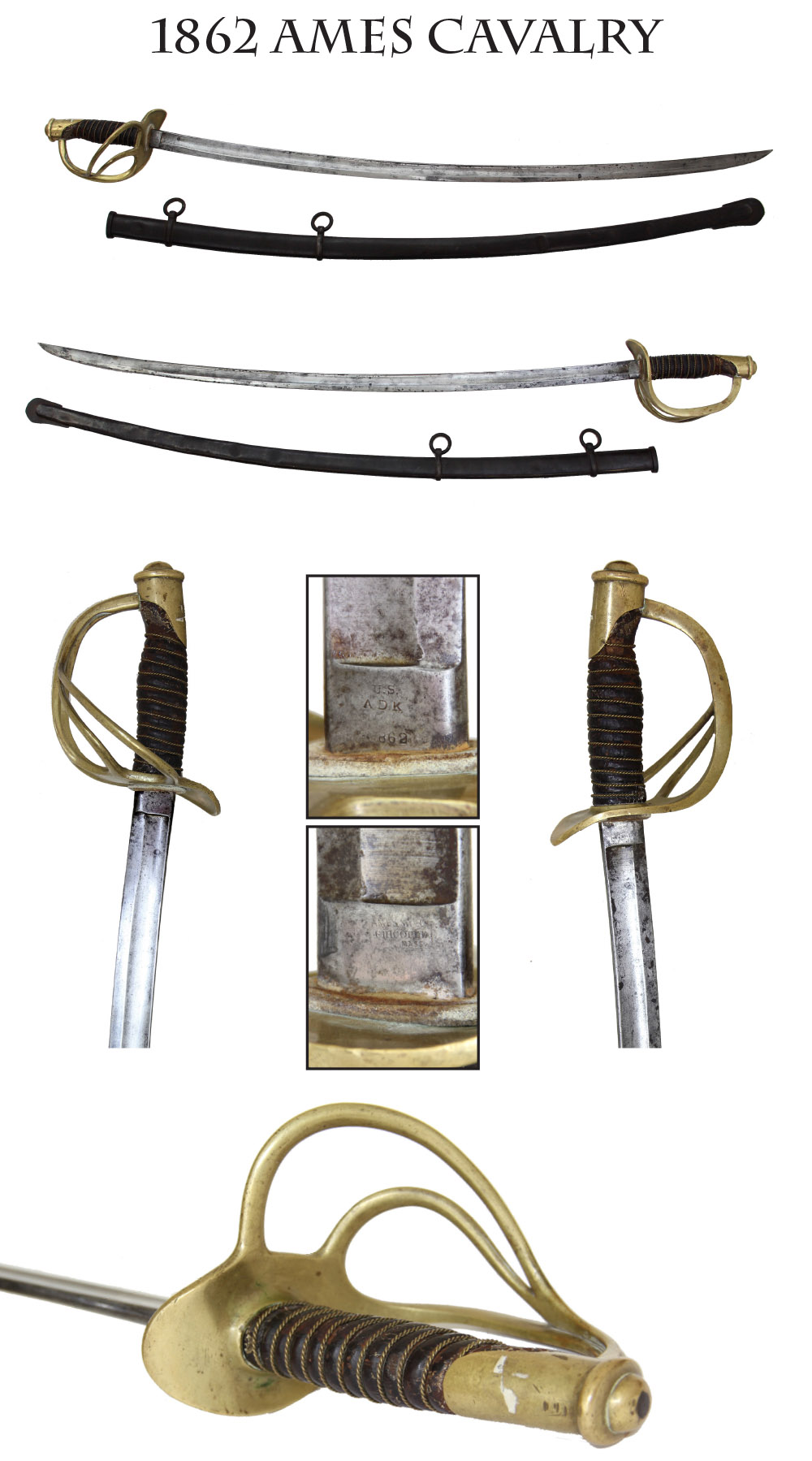
15-06-87 … 1862 Dated Ames Cavalry SaberWith 3 Matched Inspector’s Marks! …
Early-war dated Union cavalry saber by Ames. US/ADK/1862 inspector stamp on one side of the ricasso and Ames scroll engraved maker mark on the other. The quintessential cavalry weapon. Introduced in 1857 to replace the heavy cavalry saber of 1840, collectors have called it the 1860 for so long there is no need to change the terminology. This has a nice medium patina to the brass- not dark in tone, but not brightly polished. Untouched leather wrap and wire showing some abrasion to the leather from wear on the high points and up near the pommel. Wire in place, but a little loose from handling (not enough in my opinion to merit tightening it.) Leather blade washer in place. Blade a silver gray mixed with darker gray areas overall, but smooth and with good point and edge. Scabbard shows a smooth brown with throat and carrying rings in place. There are seveal shallow dents in the bottom half from wartime use. Any saber dated 1863 or earlier is tough to find and many collectors are filling out their collections by maker and by date. This one is inspected ADK on the blade, pommel cap, and drag. This would look great with an early war cavalry belt rig. Scarce with 1862 date … xx-fej-kapl
… $795.00 – SOLD
Click Here to E-mail Us!
Call us @ 419-842-1863
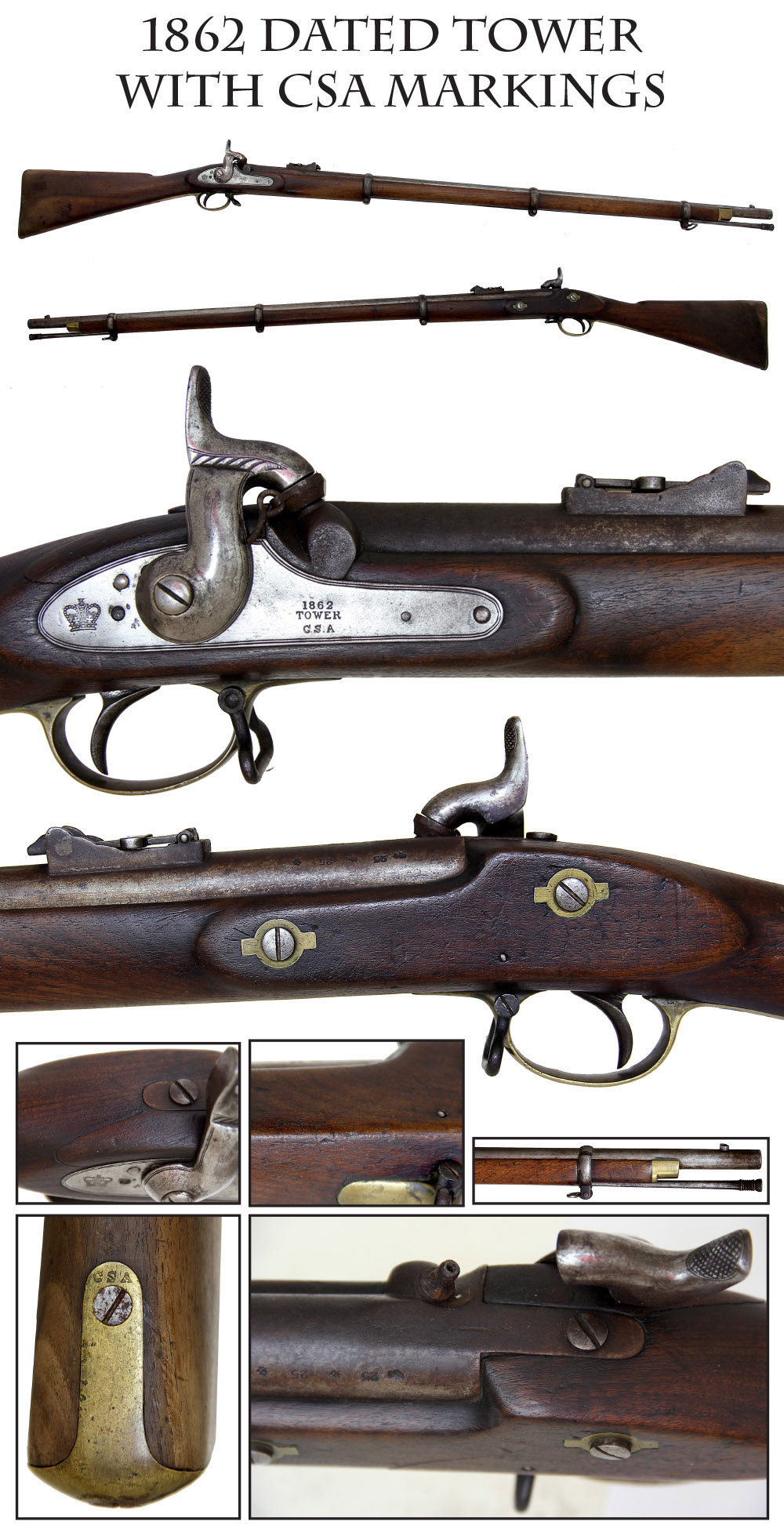
15-06-88 … 1862 Tower With CSA Markings …
1862 Dated Tower Enfield Rifle Musket / Twice Marked CSA: British pattern 1853 rifle musket, typical of those imported in large numbers by the Union and the Confederacy. All bands, swivels, front and back sights, and ramrod in place. Barrel shows mostly thin brown in the breech area and thinning out to a silver gray forward of the lower band. Bands show somewhat darker color and the rear sight still shows traces of blue. Hammer and lock plate polished bright. Sharp barrel proof and view marks with 25/25 bore marks indicating .577 caliber. Nipple protector and piece of the retaining chain still in place. Nipple shows some slight corrosion. Wood generally good, but a section extending back from between the hammer and breechplug tang has been repaired.
Lockplate with crown behind the hammer and Tower over 1862 forward. Below the date is a stamped “C.S.A.” and an identical CSA marking is on the buttplate tang. Naturally, the marking sets off all sorts of warning bells. The addition of CSA marks to antique guns, to add value, has been a common practice for generations. That may well be the case here. I don’t know if the marking was added in 1862 or 1962. What I can say is that the marking is very believable in its appearance. If I am to make an argument FOR the markings being period I would make the following observation … It would be no big deal to add a CSA mark to the soft brass of the buttplate. Any garage gunsmith can do that. HOWEVER, marking a case hardened steel lockplate is different story. On the other side of the coin … I personally almost never believe CSA marks added to European weapons. One time I had an Enfield engraved “CS” on the butt plate tang that I believed was a period marking. But even then it might have been the owner’s initials. On this gun the markings are so well done, there is a small possibility they are real. I’m not charging extra for the marks. I am selling the gun as I got it, making no claims about the marking and attaching no added value for them. It’s a legitimate P-53, the long arm imported here in the greatest numbers by both sides in the Civil War. Original and complete with a fair bore … ijj
… $1,495.00 – SOLD
Click Here to E-mail Us!
Call us @ 419-842-1863

15-06-89 … Lefaucheux Army Revolver …
Nice military 11 or 12 mm Lefaucheux pinfire revolver. I have not measured the bore. The pinfire cartridges always seem to be asking for trouble with the protruding firing pin, but the metallic self contained rounds offered weather proofing and no fumbling for percussion caps. The spur trigger guard and lanyard ring in the butt set this revolver off from the many civilian versions were see on the market. Clear Lefaucheux patent markings on the top flat of the octagonal barrel. Patent markings and serial number 24109 on either side of the frame beneath the cylinder. Tall front sight, ejector rod and loading gate all in place. Tight wood to metal fit. Mechanism needs a bit of tinkering- it indexes fine, and it will hold at half-cock, but slips from full cock. Grips a warm brown tone. Metal mostly gray with barrel, recoil shield and back of frame showing some darker traces of blue and of case … d-141115
… $595.00 – SOLD
Click Here to E-mail Us!
Call us @ 419-842-1863

15-06-90 … Project LeFaucheux Revolver …
Here’s a Lefaucheux that could use just a little work to make it complete. Round barrel version of the same pistol as above, with a spur trigger guard and lanyard ring in the butt. This one needs a loading gate and a repair to the backstrap, which has broken on one side at the corner of the aperture for the hammer. Lefaucheux patent markings on the left of frame forward of the cylinder. Serial number 4017 below the cylinder. Silver gray barrel with some dark speckling and a bit of brown rust rising aft of the conical front sight. Darker frame and cylinder. Wood to metal is tight on the left side and with just a small gap on the right, probably due to the break in the backstrap nearby. The hammer holds at half and full cock, but the cylinder does not index. An inexpensive version of a pistol that occasionally shows up in period photos in the hands of U.S. troopers … dz
… $475.00
Click Here to E-mail Us!
Call us @ 419-842-1863
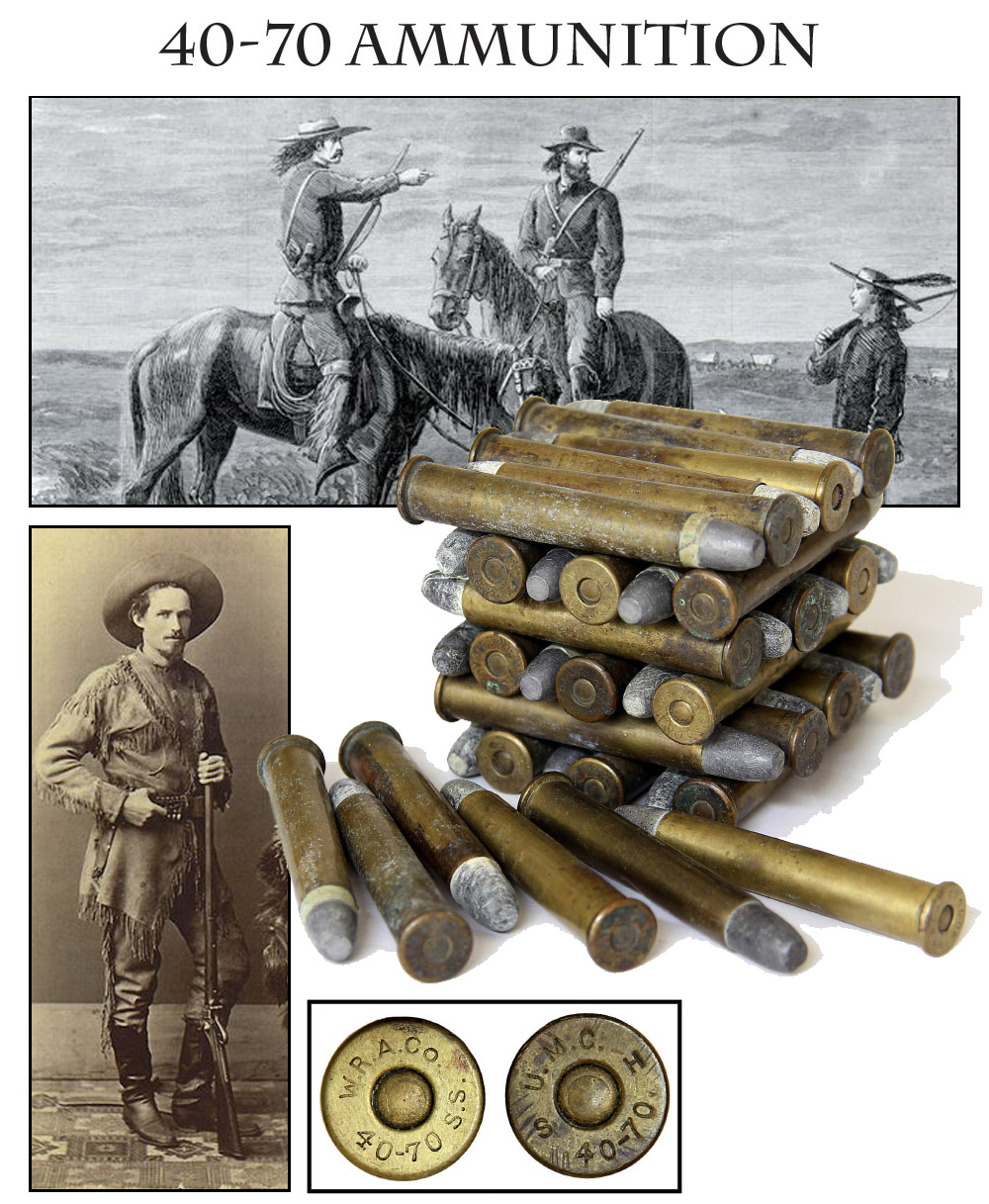
15-06-91 … 40-70 Ammunition …
.40/70 Sharps Rifle Ammunition. I got these cartridges with a dandy Double Set Trigger Sharps Mid Range Rifle a few weeks ago. These are original cartridges for the .40-70. Most of the cartridges bear head stamps from the Union Metallic Cartridge Co… UMC. We have a couple from the Winchester Repeating Arms Co. … WRA Co. Scarce cartridges from the Wild West Days
… While they last five for $75.00
Click Here to E-mail Us!
Call us @ 419-842-1863

15-06-93 … P.S. Justice Heavy Artillery Saber …
Model 1840 cavalry saber sold by P.S. Justice of Philadelphia and marked by him on the ricasso. Justice was one of the larger military retailers and was supplying the government at an early point in the war. As mentioned in connection with our other Justice saber offered above, the firm supplied some 13,000 swords on early war contracts to the government from late 1861 to early 1862. This one has a nice clean, bright blade with a few rub marks, and full wire and leather on the grip. The leather washer is in place below the guard and the brass has a nice medium patina. The Justice firm name is a bit light on the right, but the condition of the blade shows this is from a light strike, not buffing or polishing. The scabbard is likewise in the bright, with throat and rings in place and no dents or damage. A very nice example of a Justice heavy cavalry saber, excellent for an early-war cavalry display
… $975.00 – SOLD
Click Here to E-mail Us!
Call us @ 419-842-1863
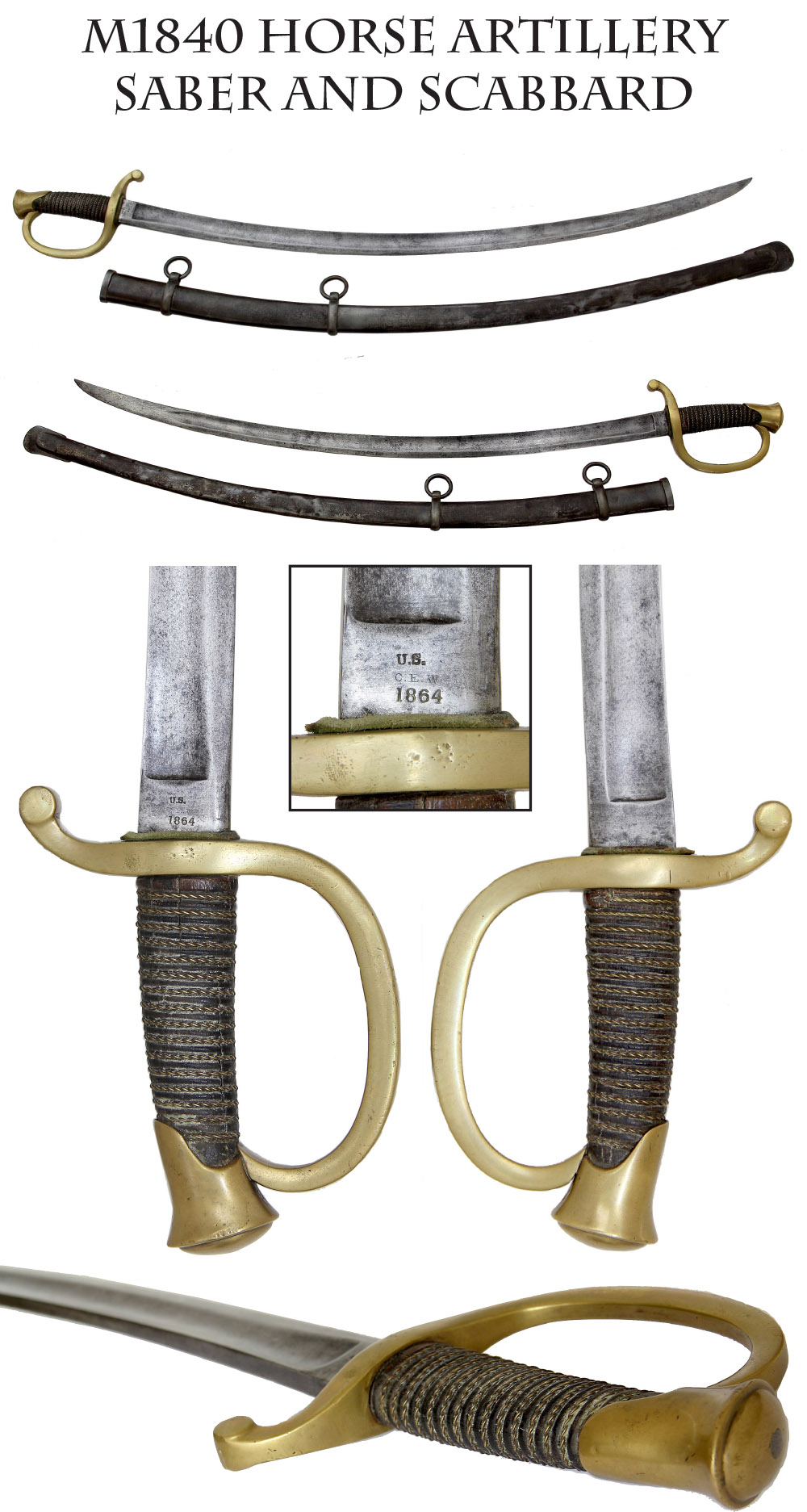
15-06-98 … M1840 Light Artillery Saber and Scabbard …
The light artillery saber was meant to offer the mounted drivers in light artillery batteries, and all personnel in horse artillery units, a weapon for personal defense. Here is an 1864 dated and inspected version certainly by Ames, though the Ames mark itself is too light on the ricasso to make out readily (the date and inspector marks are sharp- Ames scroll maker marks are notoriously light.) The grip leather and wire are good and tight, just a slight bit of wood exposed at the guard with an rubbed patina from the leather shrinking. The brass is medium in tone. The blade washer is in place. The blade has a good tip and edge. Bright mixed with silver gray overall. Scabbard is in the bright, with darker on the outboard side on the lower portions and overall on the left with a couple of small dents. Carrying rings and throat are in place… ejj-17067
… $785.00
Click Here to E-mail Us!
Call us @ 419-842-1863
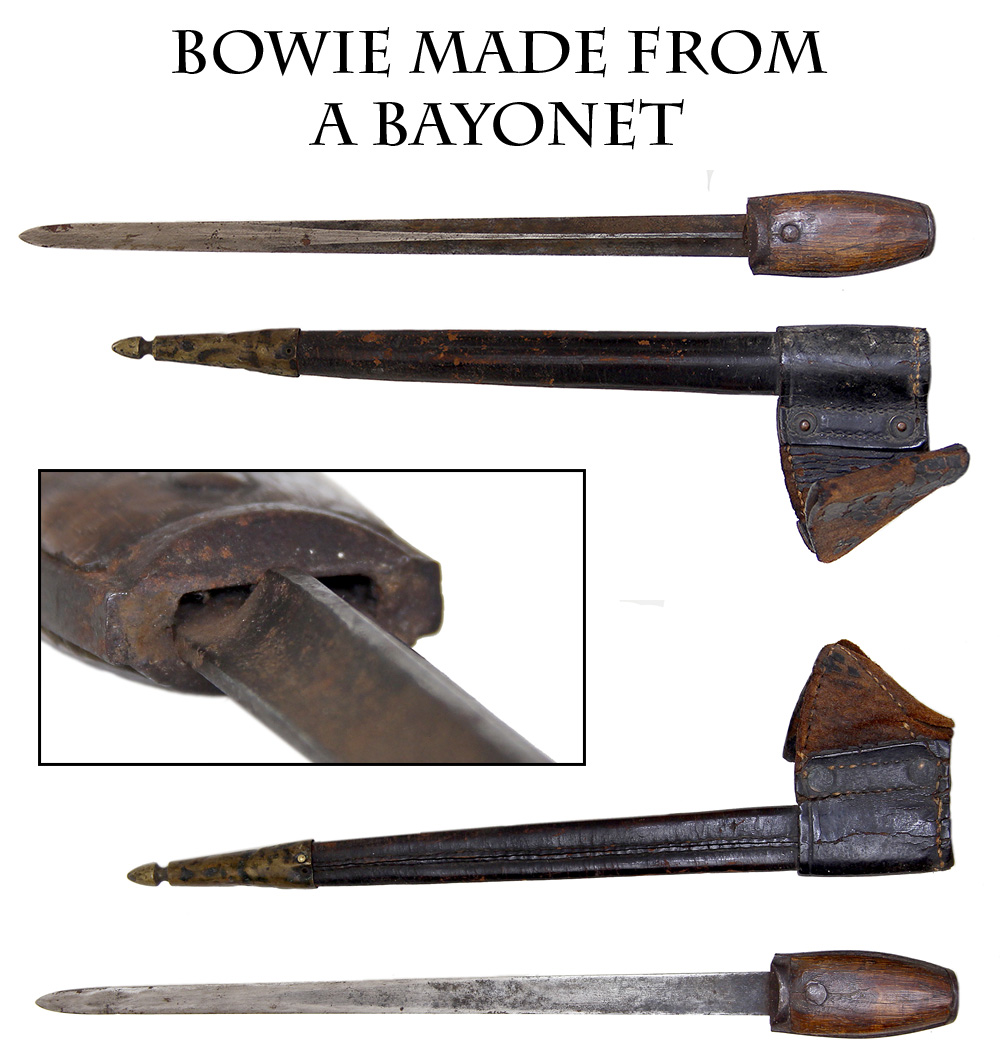
15-06-99 … 15-04-07 … Outstanding Western Frontier Knife …
About as interesting a frontier weapon as I have found. I can picture it hanging off the belt of a Western Frontiersman or Frontier Desperado or a Buffalo Skinner as he journeys through the Buffalo country in the 1870s. It is an absolutely 100% honest and genuine “stabbing knife” made from a Civil War socket bayonet and housed in the modified CW scabbard. The triangular blade is affixed to a stubby wooden handle which exhibits superb untouched wear and patina. It was unquestionably altered to this form shortly after the Civil War. The first six inches of blade retain the full angular configuration. The last few inches have been flattened down to more of a knife blade. The owner was likely a very poor man or at best extremely frugal. No fancy Sheffield blade for him — he could stab ya just as good with his home made sticker
… $495.00
Click Here to E-mail Us!
Call us @ 419-842-1863
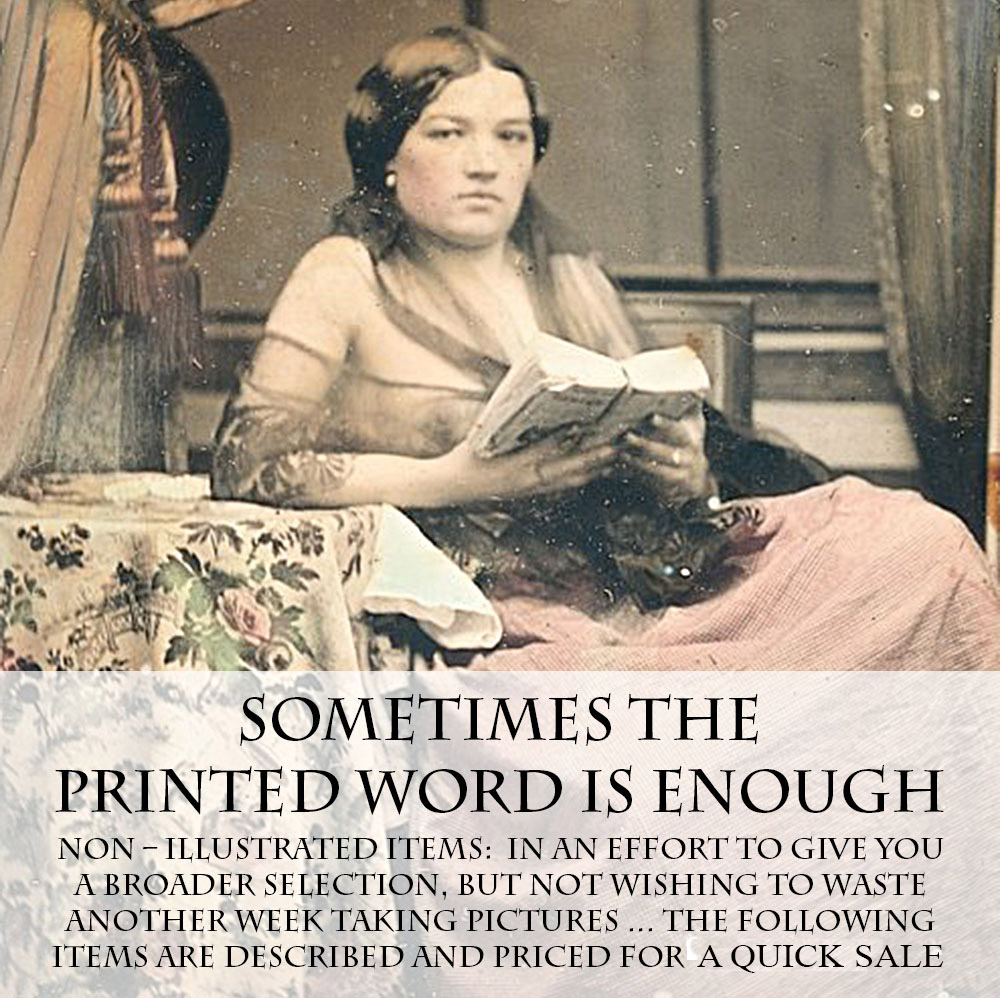
15-06-100- UP … CW OFFICER’S EAGLE BUCKLE …
A fine, attractive specimen of the rectangular officer’s ‘eagle buckle’ with fine detail to the face, and solid wreath integrally cast into the plate. Shows light age, pretty patina, and has mid war medium width tongue
… $295.00
15-06-101- UP … US OVAL BELT BUCKLE …
The standard Union issue US oval buckle with arrow hook back. Excellent condition just showing honest age and patina
… $245.00
15-06-102- UP STUD BACK US OVAL BELT BUCKLE …
Early war style US oval with lead filled back and two oval “puppy paw” studs and prong as used early in the war. Very fine showing just honest age, getting very hard to find
… $345.00
15-06-103- UP … SUPER CIRCULAR EAGLE SHOULDER BELT “BREASTPLATE” …
Non dug and EXTREMELY attractive circular eagle plate with top shelf undisturbed age patina. It even has the original leather thong stuck through the two wire loops. These were used on the infantry cartridge box shoulder strap. One of the best I’ve owned
… $235.00
15-06-104- UP … FINE 3-PRONG EAGLE BREASTPLATE …
A scarce & desirable plate being the circular eagle plate w/ lead filled back w/ 3 prongs for use with the NCO and musician’s shoulder support belt for their swords. Fine detail and great light age patina. These are nearly IMPOSSIBLE to find any more
… $375.00
15-06-105- UP … US CARTRIDGE BOX PLATE …
Identical to the US oval buckles, but having two iron wire loops on the back for securing to the flap of the cartridge box. Fine non-dug condition
… $225.00
15-06-105 B- UP … US CARTRIDGE BOX PLATE …
Another with a few bumps and dings
… $195.00
15-06-106- UP … Attic Brown M-1816 Socket Bayonet …
This is the bayonet used for decades on the Model 1816 muskets which saw service for most of the first half of the 19th century, These were used from the 1820s, through the Alamo era, through the Civil War. Of some note is the M1816 musket was so over stocked in US armories that thousands of them were given by the government to GAR posts across America after the Civil War. This one is VG condition with attic rust brown patina mixed with some light pitting. US stamping on ricasso very legible. A nice plum brown example. Good to Very Good condition
… $135.00 – SOLD
15-06-107- UP … Model 1816 Socket Bayonet …
Like the above bayonet but very good + condition. Smooth steel with gentle plum age patina, no rust, and just a smidgen of fine pitting in a couple spots. Clearly US marked
… $155.00 – SOLD
15-06-108- UP … Model 1816 Socket Bayonet …
About fine condition. Bright Steel, no rust, no pitting. A very nice example. US marked
… $175.00
15-06-109- UP … Model 1835-1842 Socket Bayonet …
This is the 1842 pattern made during the Mexican War era where the shoulders of the blade are square rather than rounded. It was used with the rare 1835 musket but more commonly with the 1842. Condition is “very good++” with the metal being gun metal grey mixed with some age patina. The US stamp is very crisp, locking ring firmly in place. This would match a ’42 musket in the $1200 – $1400 value range. Nice bayonet
… $145.00
15-06-110- UP … Extra Fine Condition Round Shoulder M-1842 Socket Bayonet
This is the rare ’42 pattern produced in the 1860s with the rounded shoulders on the blade like on the 1855-1861 examples. Rates a “fine” condition grade. Overall gun metal grey steel mixed with plum patina. There are a couple light patches of pitting on the socket but very fine. Has a crisp US stamp. A very scarce bayonet
… $250.00
15-06-111- UP … Model 1855-1861-1863 Excellent – Very good 58 Caliber Socket Bayonet …
The standard Civil War infantry bayonet. This was used from 1855 when the national armories first introduced the 58 caliber muskets… to the end of the Civil War. Overall VG condition. Grey patina. Good US stamp. Freely moving locking ring
… $155.00
15-06-112- UP … Model 1855-1861-1863 Socket Bayonet …
Fine to excellent condition. Bright Steel, no rust, no pitting. One of the better examples I have owned. This would match a gun in the $2000 to $3000 value range. Top notch
… $250.00 – SOLD
15-06-113- UP … Hall Rifle Socket Bayonet …
Very Good condition. Crisp steel with deep brown patina and a little light pitting. Looks just like an 1816 bayonet but socket aperature having an extra notch for the off-center Hall front sight. Proper for both the flint and percussion models and extremely scarce
… $395.00 – SOLD
Click Here to E-mail Us!
Call us @ 419-842-1863
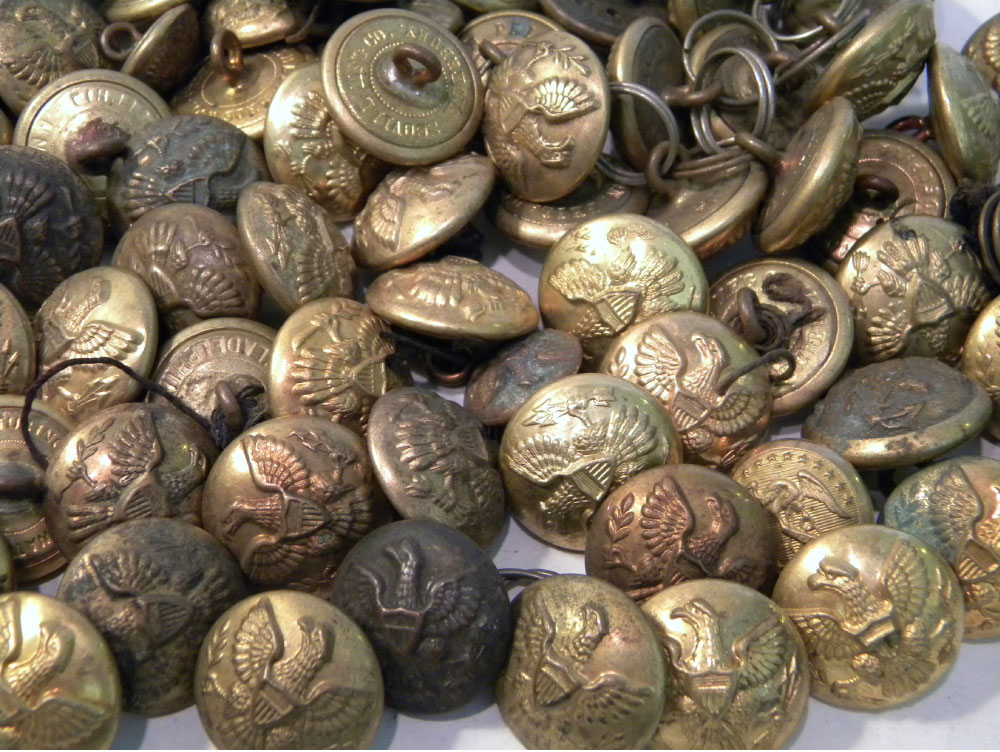
15-06-114 … A lot of TEN Original Indian War Large Size Eagle Coat Buttons.
A few years ago at an eastern Pennsylvania auction I bought a couple large bags full of these early Indian Fighters buttons and then I put them aside and forgot about them. I just stumbled across them again …. So here is a great opportunity…. ten original buttons for $25.00 These can be mailed inexpensively in a padded envelope.
… $25.00 for 10
Click Here to E-mail Us!
Call us @ 419-842-1863
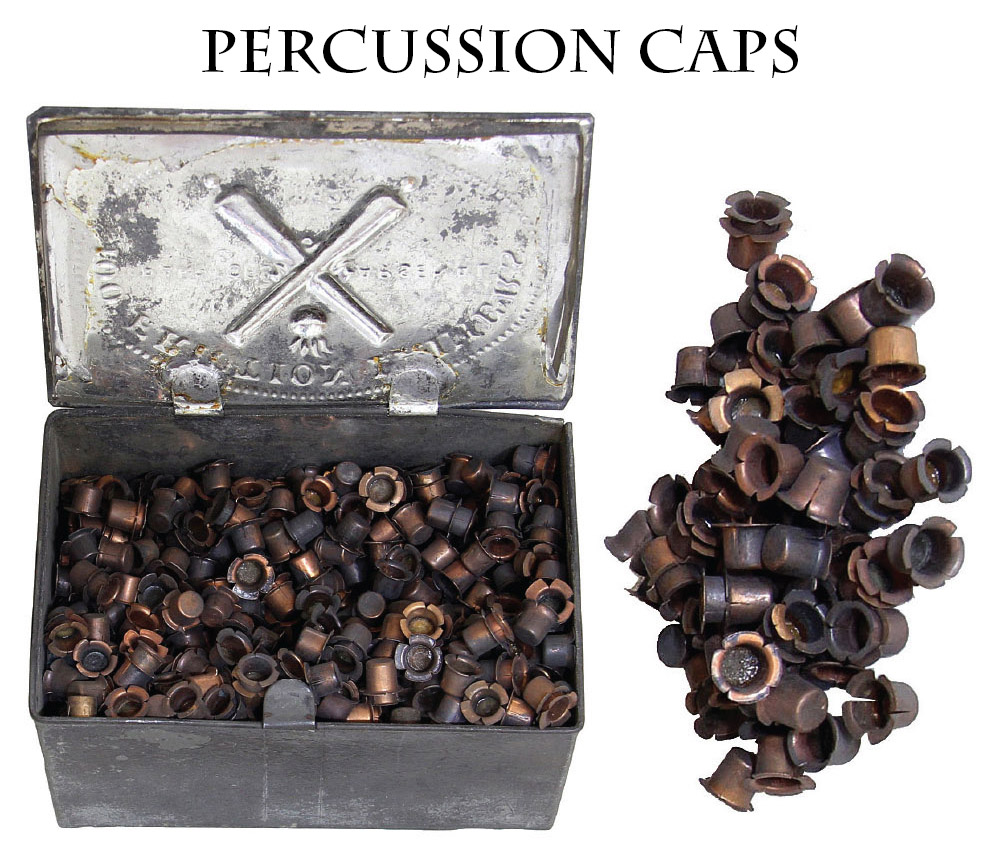
15-06-115 … Friction Primer Tin [Tin not for sale] and Percussion Caps …
I just purchased this neat old relic and am offering the percussion caps inside the tin in this offering. This very scarce tin came just as you see it, filled with percussion caps for muskets. The tin itself is the arsenal tin used to hold artillery friction primers. These are darned hard to find! I can only think of one instance where I found one still in a primer pouch! The tin has a hinged cover with small latch and embossed top reading: 100 FRICTION PRIMERS in an arc over an ordnance insignia, and FRANKFORD ARSENAL on either side. I don t know who put the percussion caps in the tin, it was certainly a handy storage idea, but since they do not belong together, I am splitting up the lot.
In each package of ten cartridges the soldier got 12 caps. While the supply lasts I will sell the percussion caps …
One Dozen … … … $15
Two Dozen … … … $25
Five dozen … … … $50
Click Here to E-mail Us!
Call us @ 419-842-1863
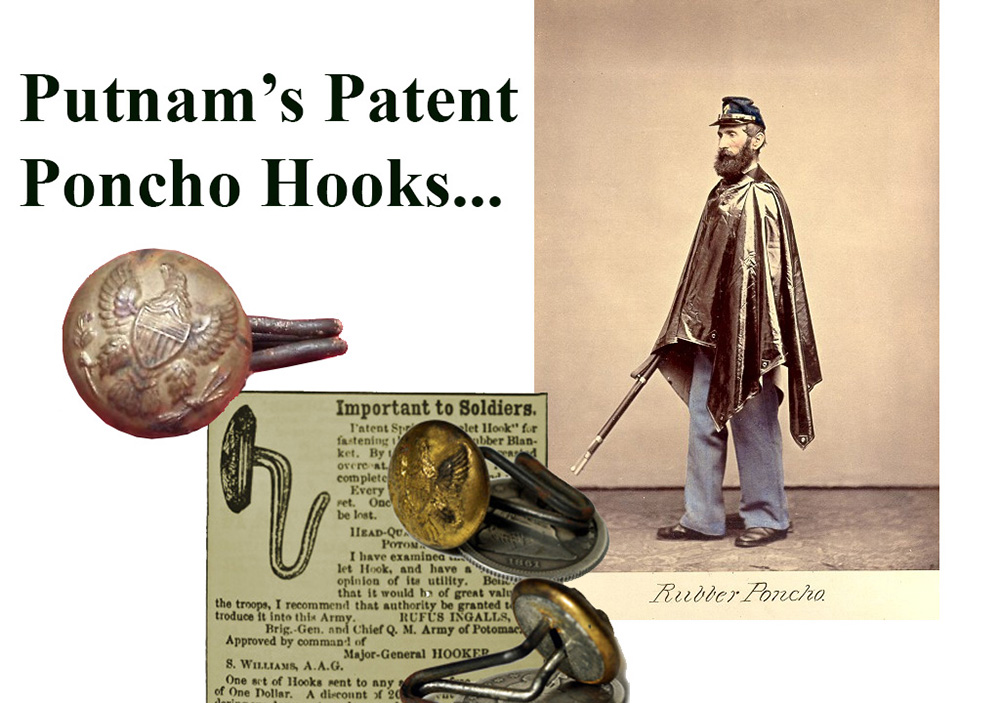
15-06-116 … These buttons were patented in 1862 by Abel Putnam
and made with a long spring shank and were designed to go through the grommets on issue rubber blankets so the sides could be connect ed and the whole thing worn as a poncho in rainy weather.The face is a standard Union Army eagle button. The back is a spring hook fashioned from double spring steel wire. I have very few priced each at
… $45.00 – SOLD
Click Here to E-mail Us!
Call us @ 419-842-1863
Layaways are Welcome
Need to split your order into multiple payments? No problem! A simple 20% earnest money deposit will hold your item for you.-acf
You can then pay it off in easy installments that fit your budget.
Read Terms Here
Items to Sell? Contact Us
I am always interested in buying ANYTHING from the American Civil War… Guns, Swords, Civil War Muskets, Knives, Uniforms, Flags, Medals, Badges, Diaries, Letters, Autographs, Buttons, photographs, tintypes, daguerreotypes, Insignia, Camp Items, Battlefield Relics, canteens, Drums, Etc… Call 419-842-1863 and ask for Dave Taylor.

